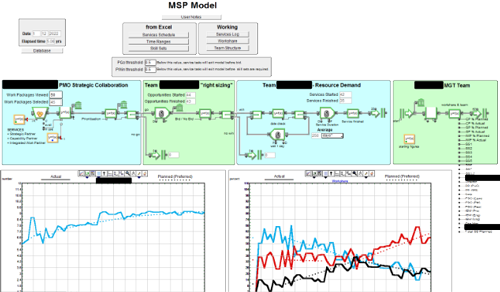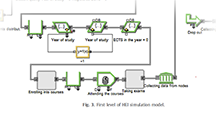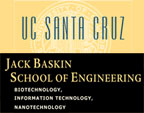Simulation enables businesses to make informed, data-driven forecasts that guide decision making, produce positive outcomes and build competitive advantage.

Lean
Analysis
Using lean analysis methodology in ExtendSim to model a supply chain network in Europe, a manufacturer realized a 98% increase in service level to the end customer plus demand could now be achieved with about 28% less inventory.

Call
Centers
Financial institution call center uses ExtendSim to analyze the number of incoming calls versus availability of personnel and can now provide an optimal level of service to their clients.

Resource
Optimization
University of Indianapolis students optimized the Humane Society's adoption process by determining that the addition of Kennel Technicians would improve overall operations by decreasing wait time, thus impacting adoption rates by 32% increase.

Claims
Processing
Employees at a claims department of a bank were specialized to manage particular types of claims so were sometimes experiencing spurts of multiple calls to manage, yet still had a low average work load. The bank used ExtendSim to analyze several options for work cells to optimize personnel utilization - increasing level of service and employee satisfaction.
ExtendSim in Business & Service Industries
- What-if analysis.
- Improving quality, revenue, and yields.
- Evaluation and implementation of Lean and Six Sigma strategies.
- Process development, assessment, and improvement.
- Risk forecasting.
- Reengineering of business processes.
- Regulating allocation of research and development resources to competing projects.
- Helping users to become a strategic thinkers and, ultimately, agents of change.
- Managing human resource problems such as the redesign of employee appraisal systems, allocation of salary increases, and hiring of employes.
Who is Using ExtendSim
 ExtendSim is being used worldwide in courses at the undergraduate, MBA, and executive MBA levels by prestigious universities such as Stanford and Harvard.
ExtendSim is being used worldwide in courses at the undergraduate, MBA, and executive MBA levels by prestigious universities such as Stanford and Harvard.- An information provider used ExtendSim to determine how to be responsive to its call center customers while managing costs.
- A plant manufacturing laminated plastic products uses an ExtendSim model to analyze metrics on performance vs. the takt times required, end-to-end cycle times and to look at overall equipment effectiveness.
- Students at Villanova University use ExtendSim to analyze the impact of Automatic Vehicle Information (AVI) systems for use on collecting tolls.
- A semiconductor company accurately simulated complex recipes and flows in ExtendSim, allowing management to explore operating strategies. Optimized productivity resulted in a 32% reduction in cycle time.
- The support requests received by the IT department of a leading oil company arrived at different rates and level of support needed - some at a higher level of urgency than others. The company's original plan had triaged requests based on specialized service areas. As this led to unsatisfactory service levels in response time, an ExtendSim model was successfully used to explore the reallocations of resources among service areas based on volume and mix triggers.
- PacBell used ExtendSim to model DSL subscriptions at the turn of this century.
- A multi-functional company was formed by aggregating several smaller regional companies, resulting in operations that consisted of numerous redundancies and multiple competing legacy systems. The company needed to consolidate operations, remove redundancies, and transition between the old structure and new. Using ExtendSim, they created a common template, like a management flight simulator, in which any process could be represented and communicated effectively. Issues common to all processes, such as resource costs or the availability, training, and movement schedules for workers were now managed centrally.
 Pitney Bowes used ExtendSim to create a Site Analysis Management Model (SAMM) that allowed precise planning and optimization of labor, equipment, and service levels in on-site business support services. SAMM links a customer's business plan to a desired level of service and protects those levels by design creating better mailroom management.
Pitney Bowes used ExtendSim to create a Site Analysis Management Model (SAMM) that allowed precise planning and optimization of labor, equipment, and service levels in on-site business support services. SAMM links a customer's business plan to a desired level of service and protects those levels by design creating better mailroom management.
Case Studies
Rob Brownie
Insight Acumen
2020
This case study is of an ExtendSim model for testing options for a Management Service Provider comprising Strategic Partner, Capability Partner and Integrated Work Partner.
Planned projects could be allocated to Provider team members with certain durations and planned skills sets with user defined or default settings. Projects have probability of go (PGo) and probability of win (PWin).
Model would produce plots of workshare over time, size of Provider team over time and skill sets required over time, amongst other metrics.
For more customer and concept models, or more on Insight Acumen, visit www.insightacumen.com.au.
Rob Brownie
Insight Acumen
2020
A case study for a Air Force Air Traffic Control (ATC) Workforce Sustainability Model built using ExtendSim. Purpose was to test the impact of increasing work demands on given capability thresholds. All demands on controllers were modelled, that is internal & external training, tactical deployments, executive workload and different leave types. Customer demand could be changed and was selectable by hour, with demand driving the required size of the ATC team on duty.
For more customer and concept models, or more on Insight Acumen, visit www.insightacumen.com.au.

Efficient Construction Management
An Integrated Simulation-Based Method for Considering Weather Effects on Concrete Work Tasks’ Productivity and Concrete Curing
Robert Larsson, Lund University
Research project in conjunction with the Swedish construction industry's organization for research and development (SBUF) and Cementa AB
September 2020
This report presents an integrated simulation-based approach to study the on-site production of concrete frameworks by considering the multiple effects of weather on work task productivity and concrete curing process. The ExtendSim model created reports simulated construction time, cost, and CO2 emissions for a specific construction setup to facilitate planning and decisions related to resource allocation strategies, construction schedules, different concrete types (including climate-improved concrete), and curing measures for different types of expected weather conditions.

Higher Education Management in Relation to Process Organization Theory
Maja Cukusic, University of Split
March 2011
This paper validates effects of online self-assessment tests as a formative assessment strategy for first year undergraduate courses. Achieved students' results such as test scores and pass rates are compared for three different generations for the same course while also being ranked against exam results of other courses taught in the same semester. The analysis points out that there is a statistically significant difference between the groups for half-semester tests and exam pass rates after online self-assessment tests were introduced. Positive effects on students' success are approximated for the overall institution using a simulation model. Results point out that a small increase in pass rates could significantly impact the overall success i.e. decrease of dropout rates.
Using ExtendSim, the author developed a model which allows extrapolation of the impact on key performance indicators (i.e. drop-out rate and study completion time) for the whole institution enabling analysis of potential opportunities. Simulated results were compared with the actual data from the information system to verify the correctness of the model.
Paper also published in:
Computers & Education - An International Journal
March 2014 • ISSN 0360-1315
Online self-assessment and students' success in higher education institutions
Knowledge Management in Call Centers: How Routing Rules Influence Expertise in the Presence of On-the-Job Learning
Geoffrey Ryder, University of California at Santa Cruz
March 2011
In this paper, the effect that routing rules have on agent learning is researched. A nonlinear optimization framework for two kinds of expertise objectives are developed: one that seeks equal distribution of experience across the workforce (effectively cross-training) and one that aims to develop specialized expertise by prioritizing the routing of specific customer inquiries to specific agents. Analytical models of call center operations are inadequate to handle this task, so instead we turn to discrete-event simulation, and evaluate the effect of routing policies on agent expertise with a custom simulator developed in the ExtendSim modeling environment. Simulation results describe an efficient frontier in routing policies that depends on the underlying expertise objective function.

Office Workers and Lifts
1Point2 - Sassenage, France
A Parisian high-rise office building used ExtendSim to simulate the flow of workers utilizing the building's elevators to determine if the elevator distribution was efficient.

Management Flight Simulator
Deloitte & Touche Consulting Group
In the mid 90s, the Deloitte & Touche Consulting Group built a Management Flight Simulator in ExtendSim to experiment with different management strategies for internal training sessions. The model focuses on the relationship between the economic factors of staffing levels, sales effort, competition, employee training, and market research. Control panels were set up within the model for trainees to vary input parameters in business factors such as staffing levels. Using this interface, class participants were able to use a sophisticated model with minimal knowledge of simulation.

Virtual Engineering's New Frontier
Kevin T. Higgins
Food Engineering Magazine - March 2003
Packages that accurately emulate the hybrid processes that characterize food and beverage manufacturing are making simulation more than just a snazzy presentation tool for upper management. Virtual Engineering's New Frontier describes users roughing out their production and packaging lines on screen to gain insight into the dynamics of their lines and where and why bottlenecks occur.


Flow architecture simulation: a powerful approach to buffer dimensioning in high-speed packaging lines
S.A.Ricardo Rodríguez & Rosana Marino - S&T - Servicio y Tecnología
Pilot experience in the adoption of performance simulation approach to design, redesign, and acquisition of bottling lines for the Zarate plant of Cervecería y Maltería Quilmes S.A. This paper discusses the management of the huge bottling resources of the company: more than 36 lines in 12 factories, in 6 countries, with an aggregated investment value of $ 200 million, occupying more than a thousand people and producing 250 million cases a year of 300 different SKUs.
Resource Optimization by Simulation Technique in Food Logistics
É. Hajnal and G. Kollár, Corvinus University of Budapest; G. Almásy, University of Veszprém; K. Kollár-Hunek, Budapest University of Technology and Economics
Applied Ecology and Environmental Research, vol 5, number 1 - May 15, 2007
Any activity that receives inputs and convert them to outputs can be considered a process. So, essentially, similar equations are used in the theory of chemical, biochemical, nuclear, mechanical, and other types of process engineering modeling. This particular research group set out identify the processes, network of processes, process variables and process equations in food logistics. This paper introduces how process building, simulation run, and optimization can be carried out in a Food Distribution Centre with a message-based discrete event simulation software - ExtendSim. Simulation usage as a decision supporting tool in the hand of company management is introduced as well as the affect of wrong decisions on the extent of air pollution coming out from cooling vehicle.

Simulation Modeling in Lean Programs
James J. Curry
Simulation modeling is a valuable complement to, rather than a replacement for, the traditional lean manufacturing analysis tools. For example, value stream mapping is a key tool; it is a good beginning. But it is static and typically only done for high-volume products or classes of products. Simulation allows the value stream map to become dynamic, and to model the range of probable val- ues—not just averages. It also allows linkages to other tools such as projected capacity utilization in a consistent manner.


Managing Service Systems with an Offine Waiting Option and Customer Abandonmen
Vasiliki Kostami, Sriram Dasu, and Amy R. Ward
Manufacturing & Service Operations Management
December 19, 2008
Many service providers offer customers the choice of either waiting in a line, or going offine and returning at a dynamically determined future time. The best known example is the FASTPASS® system at Disneyland. To operate such a system, the service provider must first make an upfront decision on how to allocate service capacity between the two lines. Then, during system operation, he must dynamically provide estimates of the waiting times at both lines to each arriving customer. The estimation of offine waiting times is complicated by the fact that some offine customers do not return for service at their appointed time.
The paper Managing Service Systems with an Offine Waiting Option and Customer Abandonment shows that when demand is large and service is fast, for any fixed capacity allocation decision, the two-dimensional process tracking the number of customers waiting inline and offine collapses to one dimension, and characterize the one-dimensional limit process as a reflected diffusion with linear drift.
The analytic tractability of this one-dimensional limit process allows to solve for the capacity allocation that minimizes average cost, when there are costs associated with customer abandonments and queueing. It is further shown that in this limit regime, a simple scheme based on Little's law to dynamically estimate inline and offline wait times is effective.
Note: This paper was made possible with the help of an ExtendSim Research Grant for the final project of Vasiliki Kostami in obtaining his PhD in Operations Management from the University of Southern California.

Videos

ExtendSim Discrete Event Tutorial - Car Wash
The key to discrete event modeling is the construction of a flow diagram using blocks to represent the problem's operations and resources. The most common discrete event model involves the handling of one or more waiting lines or queues, such as those found in supermarkets, factories, banks, etc.




 Download Report
Download Report

 Download ExtendSim Model
Download ExtendSim Model